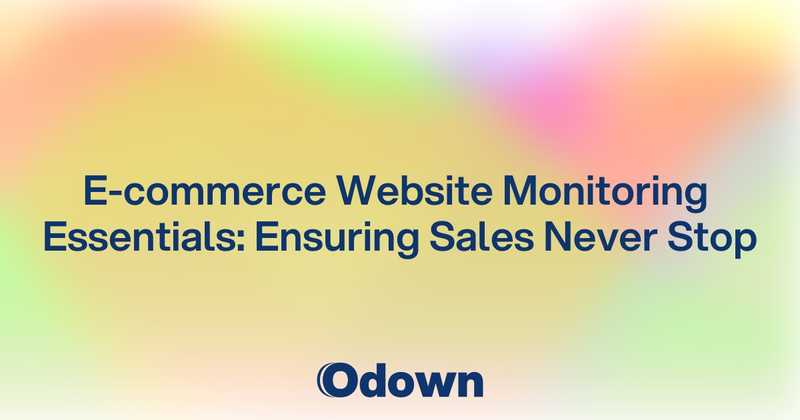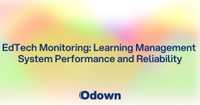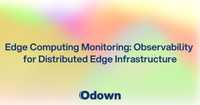E-commerce Website Monitoring Essentials: Ensuring Sales Never Stop
In today's digital marketplace, even a few minutes of downtime can cost e-commerce businesses thousands in lost sales and damaged customer trust. While custom monitoring integrations can enhance your overall monitoring strategy, e-commerce websites have specific critical points that require specialized attention. This guide explores the essential monitoring practices every online store should implement to maintain continuous operations and protect revenue streams.
Critical Monitoring Points for Online Stores
E-commerce websites are complex systems with multiple interdependent components. When monitoring your online store, these key areas deserve special attention:
Payment Gateway Dependency Monitoring
Your payment gateways are perhaps the most critical external dependency in your e-commerce operation. When these services experience issues, your ability to process transactions immediately stops.
Effective payment gateway monitoring should include:
- Status code verification: Regular checks to ensure your payment services return proper status codes
- Transaction simulation: Periodic test transactions that verify the complete payment flow
- Response time tracking: Monitoring for unusual delays that could indicate impending issues
- Certificate validation: Ensuring SSL certificates for payment endpoints remain valid
Many e-commerce businesses integrate with multiple payment providers for redundancy. Configure your monitoring to test each gateway independently and set up alerting thresholds appropriate to each provider's typical performance metrics.
Inventory System Integration Checks
Inventory discrepancies can lead to poor customer experiences, canceled orders, and logistics headaches. If your e-commerce platform integrates with external inventory management systems, these connections require consistent monitoring.
Implement checks that verify:
- Data synchronization status: Confirming inventory levels are properly reflecting across systems
- API endpoint availability: Ensuring inventory APIs remain accessible
- Update frequency verification: Checking that inventory numbers are refreshing at expected intervals
- Error rate monitoring: Watching for increases in synchronization errors that could indicate larger issues
For businesses with multiple warehouses or fulfillment centers, create separate monitoring checks for each location's inventory system to quickly isolate problems when they occur.
Mobile Checkout Experience Verification
With mobile commerce accounting for over 70% of e-commerce transactions in many sectors, monitoring the mobile checkout experience is no longer optional.
Effective mobile checkout monitoring includes:
- Responsive design validation: Verifying checkout pages render properly across various screen sizes
- Mobile payment method availability: Ensuring mobile-specific payment options (Apple Pay, Google Pay) are functioning
- Touch element functionality: Confirming that buttons and form elements respond properly to touch inputs
- Session persistence: Checking that customers can maintain their session across the checkout process
Consider implementing synthetic user journey tests that simulate the complete mobile checkout process at regular intervals to catch issues before customers encounter them.
Cart and Checkout Process Reliability
The checkout process represents the culmination of all your marketing efforts---the moment of conversion. Any disruption here directly impacts your bottom line.
Critical Checkout Components to Monitor
Your monitoring strategy should cover these essential checkout components:
- Shopping cart functionality: Verify items can be added, updated, and removed
- Tax calculation services: Ensure accurate tax computation for different regions
- Shipping rate calculators: Confirm shipping options and rates display correctly
- Discount code application: Test that promotion codes apply properly
- Order confirmation systems: Monitor that confirmations are sent and received
For each component, establish baseline performance metrics and set alerts for significant deviations. Pay particular attention to third-party services that may be incorporated into your checkout flow.
Common Checkout Failure Points
Based on analysis of e-commerce outages, these are the most frequent points of failure during checkout:
- Form validation errors: Client-side validation scripts that prevent form submission
- Session expiration issues: Premature session timeouts that force customers to restart
- Payment processing timeouts: Delays in payment authorization responses
- Inventory allocation failures: Items showing available but cannot be purchased
- Address verification service disruptions: Address validation tools becoming unresponsive
Configure your monitoring to specifically test for these common failure scenarios, with immediate alerts when detected.
Monitoring Transaction Completion Rates
Beyond monitoring individual components, track your overall transaction completion rate as a key performance indicator. Set up a dashboard that shows:
- Cart abandonment rate: Percentage of sessions where items are added but checkout isn't completed
- Checkout step completion: Conversion rates between each step of your checkout process
- Payment success rate: Percentage of payment attempts that complete successfully
- Order confirmation delivery rate: Percentage of completed orders that receive confirmations
Sudden changes in these metrics often indicate technical issues even when individual components appear operational.
Seasonal Traffic Surge Preparation
E-commerce traffic often follows predictable seasonal patterns, with dramatic spikes during sales events and holidays. Preparing your monitoring strategy for these surges is essential for maintaining performance during your most profitable periods.
Pre-Event Monitoring Adjustments
Before anticipated traffic increases:
- Decrease checking intervals: Reduce your monitoring interval times to catch issues faster
- Lower alert thresholds: Temporarily adjust alert thresholds to be more sensitive
- Add regional monitoring points: Increase geographic monitoring coverage if you expect broader traffic
- Implement queue monitoring: Add checks for request queuing on your application servers
- Test at expected peak loads: Conduct load testing that simulates anticipated traffic patterns
These adjustments help you identify and address potential bottlenecks before they impact customers during high-volume periods.
Real-Time Capacity Monitoring
During high-traffic events, focus monitoring on these capacity indicators:
- Server response time trends: Watch for gradual increases that may indicate capacity issues
- Database connection pool utilization: Monitor for connection pool exhaustion
- Content delivery network performance: Verify CDN caching and delivery remain efficient
- API rate limit consumption: Track usage rates for critical third-party services
- Payment processor capacity: Monitor for signs of payment gateway throttling
Configure cascading alerts that provide early warnings before critical thresholds are reached, giving your team time to implement mitigation strategies.
Post-Surge Recovery Checks
After traffic normalizes:
- Verify database integrity: Check for transaction anomalies or incomplete records
- Audit fulfillment queues: Ensure all orders were properly routed to fulfillment
- Inspect error logs: Review for patterns that indicate stress-related failures
- Analyze performance metrics: Compare actual performance against expected benchmarks
- Reset monitoring parameters: Return to standard monitoring configurations
These post-event checks help identify any issues that may have occurred during peak traffic but weren't immediately apparent.
Monitoring Configuration Templates for Popular E-commerce Platforms
Different e-commerce platforms have unique architectures and potential failure points. Here are platform-specific monitoring recommendations:
Shopify Monitoring Configuration
For Shopify stores, focus monitoring on:
- Theme customization functionality: Custom theme elements often break during Shopify updates
- App integration health: Third-party Shopify apps frequently cause performance issues
- API call quota usage: Shopify enforces strict API rate limits that can impact operations
- Checkout domain availability: Shopify's checkout domains are separate from your store domain
- Payment processor connections: Verify connections to Shopify Payments and other processors
Configure your monitoring to check these elements every 1-5 minutes during business hours.
WooCommerce Monitoring Configuration
For WooCommerce implementations, prioritize these monitoring points:
- WordPress core and plugin compatibility: Version conflicts commonly cause failures
- Database query performance: Watch for slow database queries that indicate optimization needs
- Session handling: Monitor PHP session management which often causes issues
- Product variation loading times: Large numbers of variations can create performance bottlenecks
- Webhook delivery success: Ensure order notifications are successfully delivered
WooCommerce stores benefit from more frequent monitoring (every 1-3 minutes) due to their self-hosted nature.
Magento Monitoring Configuration
For Magento commerce sites, establish monitoring for:
- Cache status and effectiveness: Verify caching systems are functioning properly
- Indexer status: Confirm product and category indexers are updating correctly
- Admin panel accessibility: Separate checks for storefront and admin functionality
- Cron job execution: Verify scheduled tasks are completing successfully
- Extension conflicts: Monitor for interference between multiple extensions
Due to Magento's complexity, implement comprehensive monitoring with 2-5 minute intervals and detailed transaction checks.
Implementing a Complete E-commerce Monitoring Strategy
A holistic approach to e-commerce monitoring combines several monitoring types:
- Uptime monitoring: Basic availability checks from multiple geographic locations
- Transaction monitoring: Synthetic tests that simulate complete purchase flows
- Performance monitoring: Tracking of load times for critical pages and functions
- Error monitoring: Capturing and alerting on front-end and back-end errors
- Security monitoring: Watching for unusual patterns that may indicate security issues
For optimal protection, implement monitoring from different service providers to eliminate single points of failure in your monitoring strategy itself.
Setting Appropriate Alert Thresholds
Configure alert thresholds based on the business impact of different issues:
- Critical alerts: Immediate notification for complete checkout failures or payment issues
- Urgent alerts: 5-15 minute response window for significant performance degradation
- Warning alerts: Notification of anomalies that require attention within hours
- Information alerts: Daily or weekly reporting of trends and potential concerns
Distribute these alerts to appropriate team members based on responsibility and the technical expertise required to resolve each issue type.
Integrating Monitoring with Recovery Procedures
The most effective monitoring systems are directly linked to recovery procedures:
- Document step-by-step recovery processes for common failure scenarios
- Implement automated recovery for non-complex issues where possible
- Create escalation paths for issues requiring specialized intervention
- Establish communication templates for customer and stakeholder notifications
These preparations ensure swift resolution when monitoring alerts indicate problems.
Conclusion
Effective e-commerce website monitoring is not optional---it's a business-critical investment that protects revenue and customer trust. By implementing focused monitoring for the unique aspects of online retail operations, e-commerce businesses can minimize downtime, maintain performance during peak periods, and ensure that technical issues never stand between customers and completed purchases.
Start by implementing basic monitoring checks for your most critical systems, then gradually expand coverage to create a comprehensive monitoring strategy that keeps your online store generating revenue 24/7/365.
For personalized assistance in setting up monitoring specifically designed for your e-commerce platform, contact our team for a consultation.



